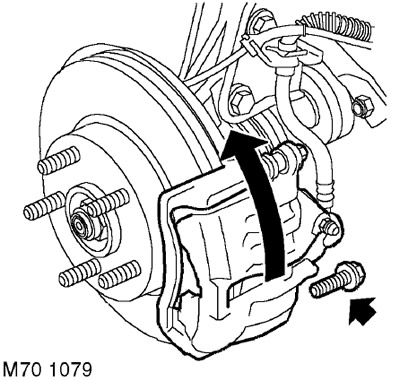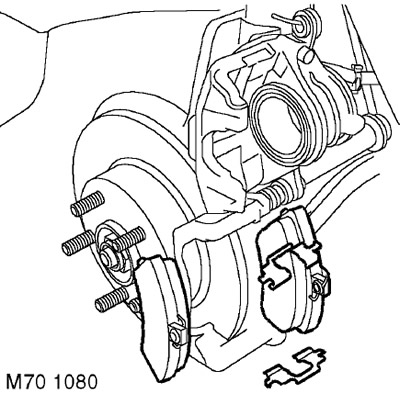Dismantling
1. Raise the front of the car.
WARNING: Do not work under a vehicle that is only supported by a jack. Always install safety props.
2. Remove the front wheel.

3. Remove the left guide pin from the brake caliper and turn the caliper up.
WARNING: In order not to reduce the efficiency of the brake system, the brake pads must be replaced at the same time on the brake mechanisms of the wheels of the same axle.

4. Remove the brake pads and their retainers from the guide.
Installation
1. Rotate the brake disc by hand to completely remove rust and other deposits from its edge.
2. Remove rust from the brake pad mounting points.
3. Use a brake cleaner to remove dust from the calipers.
CAUTION: Do not use compressed air to clean brakes. Do not use mineral based liquids. Their use may cause damage to the rubber elements.
4. Place a container with brake fluid, put the bleeding hose on the caliper fitting and loosen the fitting screw.
5. Press the piston into the cylinder and tighten the fitting screw with a torque of 10 Nm.
6. Remove the bleed hose and remove the brake fluid container.

7. Install the brake pad retainers on the rail.

8. Install the brake pads on the guide.
Small asymmetric chamfers are made on the oncoming side of the pads. This is necessary to ensure correct installation of the pads. Block 'A' (see fig.) should be installed on the inside of the caliper. Shoe B' should be installed on the outside of the caliper. The figure shows a set of pads for the left brake mechanism.

9. Lower the brake caliper down.
10. Align the edges of the guide pins with the mating surfaces on the brake caliper. Install the bolts and tighten them to 27 Nm.
11. Repeat the operation on the other side of the car.
12. Replace the wheel (wheels) and tighten the nuts to a torque of 115 Nm.
13. Remove props and lower the car.
14. Press a brake pedal several times to provide a necessary backlash between brake pads and a brake disk.
15. Check the brake fluid level and top up if necessary.
Comments on this article